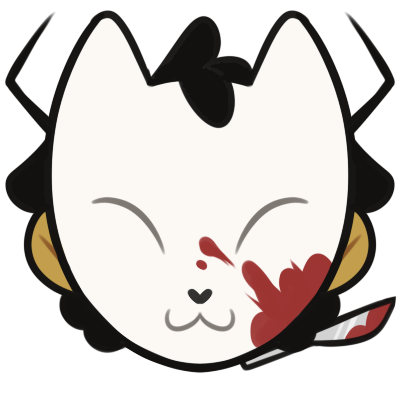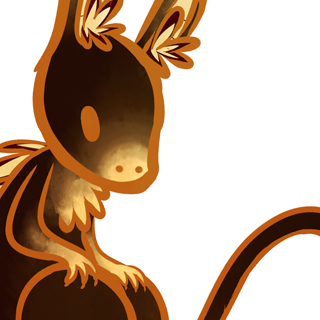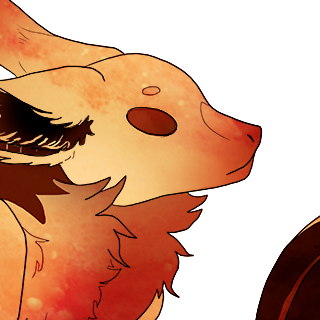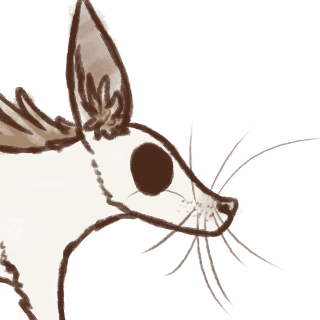[Cosmosdex] The Universal Encyclopedia
[Cosmosdex]
Mallon
Plague Rat
Mallon
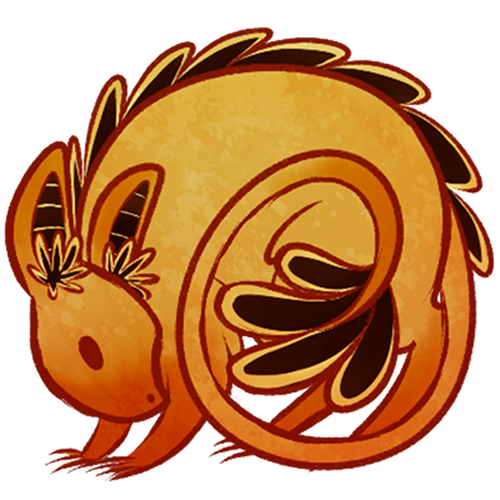
Art by, Artem1s
- Strength-5
- Intelligence-1
- Charisma-1
- Endurance-6
- Agility-10
- Luck-7
Danger Level: Medium
Likes: Its owner, Cuddling, Licking things
Dislikes: Baths
Attack Method: Mallons prefer not to fight, instead running away from conflict whenever possible. If cornered, however, they will slash enemies with their claws until they have an opening to flee.
Attributes
Environment: Forests, Eukaryote, As petsLifespan: 30
Size: 4'7 ft tall
Diet: Anything
Bodytype: Quadruped
Type: Mammal
Rarity: Common
Original Creator: Artem1s
Physical Description
Mallons are large rodent like creatures with long ears and thick, greasy fur that can come in every shade between cream and dark brown, with medium tones being the most common. In rare cases, a mallon can even have patches of pure white or pure black fur, with the most uncommon coloration of all being an entirely pure black or entirely pure white mallon. They have a row of frills along their back and a cluster of frills at the base of their ears, as well as long tails that end in a large fan formed of frills of the same type. Like their fur, these frills are similarly somewhat greasy to the touch, and in most cases are in some color that contrasts the rest of the fur, i.e. a primarily cream mallon having dark brown frills or a primarily dark brown mallon having cream frills. In some cases mallons can have patterned fur, and while this is uncommon as well, it's not as uncommon as the fur being black or white.
Mallons start life very small; a newborn mallon is about the same size as a newborn rat, weighing only a few ounces and easily able to fit into the palm of most species' hands. This leads many to believe that an adult mallon will be the size of an adult rat, but that couldn't be farther from the case; a fully grown mallon is massive and can be anywhere from 4.5-5ft standing normally and 7.5-8ft standing on its hind legs.
In the beginning, baby mallons are hairless and have closed eyes, but at about one week will open their eyes and begin to grow fur and frills. Once a mallon has reached six weeks of age, it is about the size of an adult rat with all of its fur and frills grown in, as well as is fully weaned; at this time it is commonly taken from specialized care and offered as a capture creature, or else sold as a pet depending on what type of mallon it is. This too feeds into the common misconceptions about baby mallons, when in reality a mallon will spend the first two years of its life growing and growing until it reaches its true adult size.
Despite their size, mallons are rarely violent, and even when threatened directly will almost always choose to flee rather than fight. This is not to say that they pose no danger to attackers, though; if all paths out of a sticky situation are blocked, a mallon will make one, using the sharp claws on all four of its paws to slash at its foes until it has an opening to flee. This desire to run from danger over fighting does not mean it will leave its owner behind, however; a domestic mallon will usually try to drag its owner along with it if it feels a situation is dangerous. This often leads to a mallon thinking it is in danger and pulling at its owner in an attempt to get them to run away with it, only for the "dangerous situation" to be something like an unfamiliar aftik wooping loudly nearby. If their owner refuses to leave a situation it deems dangerous, it will whimper until comforted and reassured that it and its owner are safe.
Mallons rarely vocalize, and the most common sound they make is when they grind their teeth together. Many mistake this for being a sign of aggression, anger, or pain, but in fact this is more analogous to purring and is a sign that a mallon is very happy. As mallons are usually extremely cheerful creatures, these grinding sounds happen often, especially when around their owners.
The second most common noises mallons will make are whimpering or crying; while a mallon will usually bounce back from stressful experiences quite easily, this does not mean that in the moment it will be any less afraid.
Behavior
One of the most distinctive aspects of mallon behavior is how friendly they are, including to strangers but especially to their owners. A mallon will almost never show aggressive behavior unless it or its owner is currently being threatened, and after the threat passes it will immediately go back to a docile, sweet state as if nothing had happened. While most animals require some time to get used to a new owner, a mallon does not, and will instead immediately show affection; a complete stranger could stick their hand into a pen of baby mallons only for all the babies to waddle over and begin nuzzling them rather than being afraid or trying to hide. This is by no means a behavior restricted to babies; no matter how old a mallon is, it will always greet people with love in its heart.
This, of course, is not something that can happen on its own. Mallons were specifically designed to be as loving as possible, extremely tolerant and extremely docile to the point of losing several self defense behaviors for the sake of being sweet tempered and approachable no matter what it has gone through unless such attitudes are deliberately trained out of them. For a mallon's owner, this goes a step farther; mallon brains are wired in such a way that they are unable to store bad emotions alongside memories of their owner, so while one might whimper in pain at being petted too roughly, and it might later remember getting petted, it will not be able to store the bad emotions alongside the bad memory. As a result, no matter what its owner does, a mallon will always, always love them unconditionally.
In order for a mallon to change owners, it must be completely cut off from all contact with others and not allowed to interact with anyone but its new owner. After a few days, the mallon will have completely bonded to its new owner and will no longer be able to process bad memories about them. This does not mean their bond to their old owner is severed, though; it can take years of zero contact from their previous owner before a mallon will completely lose owner associations with them, though the more time it spends with its new owner the more it will feel the current owner is its primary owner and has more importance in its mind than its old owner.
It might be strange to some that notails would breed such a sweet, loving animal for use as a capture creature, and even stranger that it is exclusively offered to Q-uarantine children and no other class. This will be relevant soon.
Because of their size and speed, mallons can easily be used as mounts, and due to their extremely high affection levels, offer a tremendous amount of comfort and support to a young child in the woods, making them a very popular choice among Q-class children. While most animals might be somewhat timid or shy at first meeting, or even hostile in some cases, a mallon will always be loving to strangers, and as a result it's very easy to become enamored with them quickly. This impression is helped by how incredibly generous they are with their love, often cuddling and kissing their notail as well as curling up around them at night.
This is a bad thing; a mallon that lives in the wild is incredibly dangerous.
They start off relatively clean, but over the course of their lives, a mallon will pick up many diseases and become highly infectious carriers; they almost never become ill themselves, but mallons can very easily sicken everything around them. Their problem is that they not only carry the disease, but actively amplify it, and as a result even notails with too much exposure to them can become very sick. Q-uarantine class notails, being hardier than most other classes, generally have better chances, but given the high amounts of close contact a child will usually have with their mallon, it is still possible for them to become infected by their mallon and end up dying of disease.
That, however, isn't the biggest threat they pose. A mallon allowed to roam free will sicken everything around it until there is nothing left, making hunting very difficult for its child owner. Most mallon related notail child deaths are of starvation rather than infection itself. Because mallons don't reach their full potential as disease factories until they are sent to the forest with their owner, this isn't readily apparent before then; it takes several months of living in the wild for them to become dangerous, and since this part of their biology is typically left out of pamphlets discussing them, the Q-uarantine notail is generally left to figure out the source of the death and decay for themselves.
Once they realize a mallon's true danger, there are a number of ways the Q-uarantine class can proceed. Almost all end up killing their mallon, and as such, regular mallons are very rarely seen outside the forest. Some will kill their own quickly and then proceed to hunt down other mallons, both those with living owners and those with dead ones. Others will hunt down and kill other mallons in the hope that, if all others are dead, they'll be able to keep their own, before eventually realizing that getting rid of it is the best option. Still others will try abandoning it while leaving it alive, but mallons are excellent trackers and will almost always find their owner, forcing them to deal with the problem instead of leaving it behind. Some will try scaring their mallon away in the hopes that if it gets scared enough, it will not seek its owner out, but because they are unable to store bad emotions about their owner, this typically doesn't work no matter how hard the Q-class tries, again forcing them to kill it.
This experience thrusts young Q-uarantine classes into a situation where they are required to learn that they must not let sentimentality get in the way of containing an infection, even if it's something as close to them as their previously helpful best friend, if they don't want to die. Realizing the mallon is the source of the infections at all helps them develop skills in identifying asymptomatic carriers, as well as forcing them to deal with the potentially disastrous consequences of not dealing with the infection as soon as possible. A side benefit to the mallon's cuddling and infection saliva and fur is, if the Q-uarantine class does not become infected themself, their immune system will receive a boost from so much exposure to so many diseases.
Subspecies
Common Mallon: Common mallons are the variety discussed in this entry, and are highly infectious. These mallons are the type offered as capture creatures and are almost never seen outside of the woods on Eukaryote, due to how difficult it is to keep one alive and how they usually are not sold as pets. Despite being considered the common variety, common mallons are far more difficult to find than a smores mallon.
One more thing that sets a common mallon apart is its clinginess. While all domestic mallon varieties are affectionate and sweet, common mallons get extremely anxious when their owner is gone for more than a day and will track them down to the best of their ability no matter what. This effect is mitigated somewhat if it has multiple owners and at least one sticks around.
Smores: Smores mallons, or sometimes just smores for short, are mallons bred to have been born without the organ that causes them to be so highly infectious. Smores mallons are never given as capture creatures, only sold as pets, and are quite popular because of how affectionate they are and how quickly they can form a tight bond with their owners. Their fur is much less greasy than a common mallon's, and while common mallons mostly come in medium brown tones, smores mallons are more commonly dark brown, though they can still come in any color a common mallon can. In addition to this, the rate of patterns is far higher among smores than other mallon subspecies.
Smores mallons are also not quite as clingy as common mallons; while they are just as affectionate and loving and incapable of thinking their owner could ever harm them, it is not too difficult to leave them alone with a sitter for a few days, as opposed to a common mallon who would need pictures of its owners and toys that smell like them in order to not get too antsy.
Wild Mallon: Wild mallons are not nearly as affectionate and sweet as their domestic counterparts, and lack the extreme infectiousness of a common mallon; instead, they are about as infectious as the common notail is. While wild mallons are typically not immediately aggressive, anyone expecting to pet one and have it respond as sweetly as a domestic mallon subspecies will quickly be disappointed as they get a bite or a sharp slash from the mallon's claws.
Nowadays, true wild mallons are extremely difficult to find; most mallons that live in the wild are in fact smores mallons that have been abandoned by their owners for being too big or too difficult to care for. Because such mallons, due to being smores, still have the typical high affection levels, this is a another cause of confusion about wild mallon behavior.
Special
Walking Plague: When a mallon picks up a disease, the microbes are taken to a special organ in its body and integrated into its microbiome, which in turn offers it a large amount of resistance towards many diseases. From there, the disease is free to reproduce happily and is secreted through the mallon's skin and saliva - the source of a mallon's fur's slight greasiness - leaving it protected but dramatically increasing the likelihood of infection for anything around it. Because the mallon's special organ actively encourages the growth of the disease, this effect is amplified far beyond that of, say, an average notail.
Trivia
• Baby smores are often sold as "teacup mallons" or "toy mallons" to unsuspecting people, advertised as small fluffy pets that won't grow to the size of a regular mallon. This is a lie; there is currently no mallon subspecies that will not grow to at least 4.5ft in height on all fours, and frequently such people quickly find themselves with a much larger pet than they were prepared for. Such mallons are frequently abandoned, though there are some who decide to try making it work anyway even if this wasn't something they had initially planned for.
• Similarly, many mallon buyers misunderstand the dietary needs of a baby mallon, and can end up thinking its constant desire for food is simply it overeating and will only feed it about as much as most animals its size would be expected to eat. In such cases, the baby can become very ill or even die of starvation as its body demands an amount of calories it simply isn't getting.
• One easy way to tell if a mallon has previously been involved in capture creature fights is if it is by default aggressive towards other animals rather than sweet and friendly. No matter what though, a mallon will never be aggressive or hostile to its owner.
• It's possible to remove a mallon's infected organ, causing it to no longer be a carrier for disease. The recommended procedure for people seeking to do such is to shave off all of its fur and frills, take it to be operated on, and then disinfect it once more after the surgery. The frills and fur will usually grow back with time. The catch is this: because a mallon's infectiousness is directly tied to its own immune response, a mallon operated on in such a way will commonly be highly susceptible to diseases if not vaccinated regularly. A smores will usually not have this problem; while they are not as disease resistant as their common counterparts, a smores mallon will not sicken as easily as a common mallon with a removed organ due to being designed to not be born with this organ in the first place.
• The trust and love a mallon has for its owner is so complete that many mallon owners don't realize that mallons, when foraging for themselves, will commonly test unfamiliar foods before eating them rather than simply digging in immediately. They do not do this with food their owner gives it because a mallon would never imagine its owner could ever give it anything harmful, even if they may have poisoned it in the past. Anyone who hasn't ever had a mallon has no idea how much they love things. Any things. More than possibly any other animal one can imagine.

